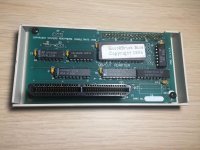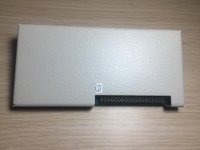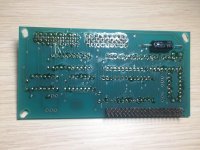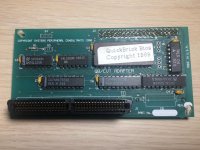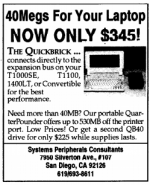Using some sort of adapter that came with my PC Convertible when I got it, Ive managed to get it to recognize an external hard drive. The adapter plugs into the rear expansion port and contains a pcb with some chips on it, one of which is labeled Quickbrick BIOS Copyright 1989, the board has Copyright Systems Peripheral Consultants 1990 printed on it. It connects to a hard drive using a 40 pin IDE cable, currently I have it connected to a miniscribe 8225 because thats what it happened to come with. The Convertible boots up, the hard drive lights up and spins some during POST, and DOS allows me to switch to the C: drive without an error. I cant seem to find anything about using an HDD with a Convertible online, and Im having some issues with it, so I figured here would be the place to ask.
First, I cant actually fully access the drive. DOS allows me to switch to drive C, but attempting to run any commands (dir, chkdisk, frisk, format) it outputs General Failure error reading drive C. As the hard drive itself is fairly old, and was sent through the mail and probably knocked around a bit, is this likely to be an issue with the drive itself as opposed to the computer?
Second, inexplicably whenever I boot up the Convertible with the hard drive adapter in, the A drive continuously has the activity light on and spins. It doesnt stop spinning until the computer is powered off, but has no problem actually reading the disk or running programs from it. Is this a known problem, and is there any fixes?
Also, this is more of a question than a problem, but if I were to find an IDE 3.5 or 5.25 in floppy drive, is it likely that this would work too? Or is a hard drive too different from a floppy drive?
Thanks in advance for any advice or suggestions!
First, I cant actually fully access the drive. DOS allows me to switch to drive C, but attempting to run any commands (dir, chkdisk, frisk, format) it outputs General Failure error reading drive C. As the hard drive itself is fairly old, and was sent through the mail and probably knocked around a bit, is this likely to be an issue with the drive itself as opposed to the computer?
Second, inexplicably whenever I boot up the Convertible with the hard drive adapter in, the A drive continuously has the activity light on and spins. It doesnt stop spinning until the computer is powered off, but has no problem actually reading the disk or running programs from it. Is this a known problem, and is there any fixes?
Also, this is more of a question than a problem, but if I were to find an IDE 3.5 or 5.25 in floppy drive, is it likely that this would work too? Or is a hard drive too different from a floppy drive?
Thanks in advance for any advice or suggestions!

